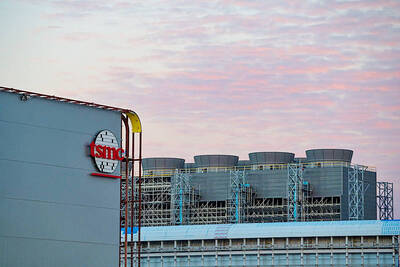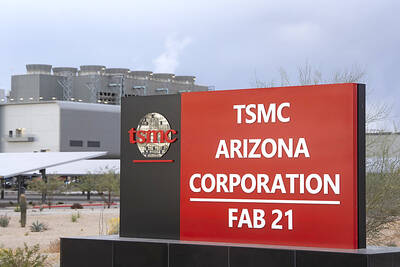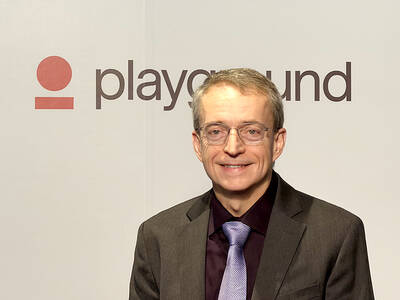Leave it to a few intrepid aviation dreamers and a team of financiers to usher in a new era in space exploration.
Tomorrow, they will make the first private attempt to launch a man into space in what they hope will be the seminal first step towards mass space travel.

PHOTO: AFP
The action will start early tomorrow from a dusty airstrip in the barren Mojave desert in southeastern California, where Burt Rutan, a legendary but maverick aviation designer will roll out SpaceShipOne for a flight that could change aviation history.
The bulbous rocket will first be carried aloft aboard a spindly white jet plane to a height of some 16km. The pair, described by technology magazine Wired as "resembling a dragonfly mating with a winged bratwurst" will then separate, and the rocketship's pilot will ignite its engine for an 80-second burn.
That will shoot SpaceShipOne to three times the speed of sound, sending it 100km above the Earth's surface. For a few seconds the unnamed pilot will feel the silence, blackness and weightlessness of space.
Then the rocket will re-enter our planet's atmosphere, diving back down to earth, before its wings move, coaxing the ship to a gentle glide back to earth, according to the team's plan.
The men behind the project are designer Rutan, who is without doubt the closest thing that avionics has to a celebrity. His designs include the "Voyager," the first plane ever to fly around the world nonstop without refuelling.
The project has been funded by Microsoft co-founder Paul Allen to the tune of US$20 million. He may get some of it back if SpaceShipOne follows up Monday's flight by winning the US$10 million Ansari X prize. This will be given to the first team to successfully launch a manned spaceship carrying the weight of three people into space, twice within a period of two weeks.
But the ultimate prize is much bigger than that. Developing a successful private space vehicle would allow them to lead the way in developing space tourism, where flights would be sold to wealthy individuals for more than US$100,000 a pop.
Even more significantly is that success would place them in a prime position for new government contracts that are at the heart of plans to reform the US space agency NASA by granting a much greater role to private enterprise.
NASA has held a complete monopoly over space exploration for the last 40 years. But as the Economist magazine noted in a recent issue, the "agency has done so in a spectacularly expensive fashion, wasting hundreds of billions on projects that fail to live up to their billing."
The space shuttle is hugely expensive, fatally unreliable, and like the International Space Station that it is meant to service, thought to be largely superfluous to the scientific reasons for space travel.
NASA's bureaucracy is notorious, and when it does hand out some of its US$15 billion budget to private firms, the work mostly goes to just two giant aerospace firms, Boeing and Lockheed Martin.
This means that creative entrepreneurs have had virtually no impact on advancing the space frontier.
Now, if all goes as planned at 6:30 tomorrow morning, a small team of designers, engineers and yes, space visionaries, are about to launch a man out of the earth's atmosphere at a price that would probably not cover the NASA coffee budget.
Rutan is renowned for coming up with brilliant and cost effective engineering solutions. In the case of SpaceshipOne his plans called for cobbling together existing technologies for a project that will become far more than just the sum of its parts.
That, say his critics, is his weakness.
"You've got to put this in the right context," said Mark Lewis, a professor of aerospace engineering at the University of Maryland.
"Taken in and of itself, it's not a big deal. They've got a small cockpit on a rocket engine. The speeds they're reaching are speeds we reached 50 years ago. The concept of dropping the craft from a carrier plane is great, but we were doing that back in the World War II era."
Others claim that the private space effort will fail at the first hurdle.
"My take on SpaceShipOne is that it won't make altitude" when it comes time to go for the X Prize, said Randa Milliron of Interorbital Systems, a Scaled Composites competitor. "It might be able to just kiss space with one person on board," Milliron said.
"But with three people? If he does it, he'll be extremely lucky."

The number of Taiwanese working in the US rose to a record high of 137,000 last year, driven largely by Taiwan Semiconductor Manufacturing Co’s (TSMC, 台積電) rapid overseas expansion, according to government data released yesterday. A total of 666,000 Taiwanese nationals were employed abroad last year, an increase of 45,000 from 2023 and the highest level since the COVID-19 pandemic, data from the Directorate-General of Budget, Accounting and Statistics (DGBAS) showed. Overseas employment had steadily increased between 2009 and 2019, peaking at 739,000, before plunging to 319,000 in 2021 amid US-China trade tensions, global supply chain shifts, reshoring by Taiwanese companies and

Taiwan Semiconductor Manufacturing Co (TSMC, 台積電) received about NT$147 billion (US$4.71 billion) in subsidies from the US, Japanese, German and Chinese governments over the past two years for its global expansion. Financial data compiled by the world’s largest contract chipmaker showed the company secured NT$4.77 billion in subsidies from the governments in the third quarter, bringing the total for the first three quarters of the year to about NT$71.9 billion. Along with the NT$75.16 billion in financial aid TSMC received last year, the chipmaker obtained NT$147 billion in subsidies in almost two years, the data showed. The subsidies received by its subsidiaries —

Shiina Ito has had fewer Chinese customers at her Tokyo jewelry shop since Beijing issued a travel warning in the wake of a diplomatic spat, but she said she was not concerned. A souring of Tokyo-Beijing relations this month, following remarks by Japanese Prime Minister Sanae Takaichi about Taiwan, has fueled concerns about the impact on the ritzy boutiques, noodle joints and hotels where holidaymakers spend their cash. However, businesses in Tokyo largely shrugged off any anxiety. “Since there are fewer Chinese customers, it’s become a bit easier for Japanese shoppers to visit, so our sales haven’t really dropped,” Ito

OUTLOOK: Pat Gelsinger said he did not expect the heavy AI infrastructure investments by the major cloud service providers to cause an AI bubble to burst soon Building a resilient energy supply chain is crucial for Taiwan to develop artificial intelligence (AI) technology and grow its economy, former Intel Corp chief executive officer Pat Gelsinger said yesterday. Gelsinger, now a general partner at the US venture capital firm Playground Global LLC, was asked at a news conference in Taipei about his views on Taiwan’s hardware development and growing concern over an AI bubble. “Today, the greatest issue in Taiwan isn’t even in the software or in architecture. It is energy,” Gelsinger said. “You are not in the position to have a resilient energy supply chain, and that,